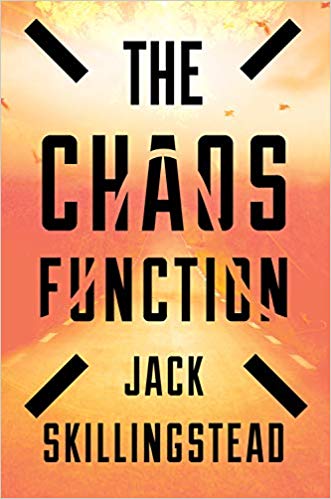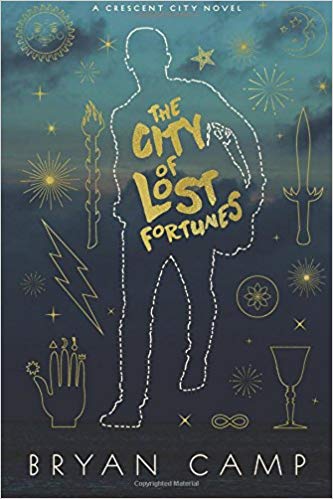 The Chaos Function by Jack Skillingstead
The Chaos Function by Jack Skillingstead Format: eARC
Source: supplied by publisher via Edelweiss
Formats available: hardcover, ebook
Genres: science fiction, thriller, time travel
Pages: 304
Published by John Joseph Adams/Houghton Mifflin Harcourt on March 19, 2019
Purchasing Info: Author's Website, Publisher's Website, Amazon, Barnes & Noble, Kobo, Bookshop.org
Goodreads
For readers of the best‑selling novels Sleeping Giants and Dark Matter, an intense, high‑stakes thriller with a science‑fiction twist that asks: If technology enabled you to save the life of someone you love, would you do so even if it might doom millions? Olivia Nikitas, a hardened journalist whose specialty is war zones, has been reporting from the front lines of the civil war in Aleppo, Syria. When Brian, an aid worker she reluctantly fell in love with, dies while following her into danger, she’ll do anything to bring him back. In a makeshift death chamber beneath an ancient, sacred site, a strange technology is revealed to Olivia: the power to remake the future by changing the past. Following her heart and not her head, Olivia brings Brian back, accidentally shifting the world to the brink of nuclear and biological disaster. Now she must stay steps ahead of the guardians of this technology, who will kill her to reclaim it, in order to save not just herself and her love, but the whole world.
My Review:
There’s a quote from The Rubaiyat of Omar Khayyam that goes,
“The Moving Finger writes; and, having writ,
Moves on: nor all thy Piety nor Wit
Shall lure it back to cancel half a Line,
Nor all thy Tears wash out a Word of it.”
This is a story about what happens when someone has the power to lure that Moving Finger back to cancel more than half a line – but does not – as no human does – have the wisdom to determine whether that cancellation was, or was not, the right thing to do.
This book was simply a wow.
Of course, it’s also just a bit more complicated than that. Also just saying it’s a wow isn’t really an informative review – although it certainly is succinct.
At first, this seems like a near-future dystopian novel, until it isn’t. And then it is again. And then it isn’t.
Still confused? I think it’s intentional – at least on the part of the story.
Olivia is an investigative journalist chasing a story in Aleppo, Syria, just a little more than a decade from now. Her world doesn’t feel much different from ours in time, only in place. The seemingly permanent, perpetual civil war/uprising/revolution/counterinsurgency/whatever that she is covering is worlds away from the comfortable life that still very much exists back in the US.
But Olivia makes her living covering what she calls the “Disaster”. A disaster that could be anywhere, and often is – just not back home. Also a disaster that seems to be a direct consequence of actions taken in our present, as the Syrian conflict that she is covering is the war to overthrow Assad, which has its roots in our now.
She’s attempting to cover violations of the current, tentative peace agreement when she, her guide and her aid worker-lover get caught in the crossfire – and the world changes.
And changes again. And again. And it’s all Olivia’s fault… Really, it is.
Brian is killed in that crossfire, and Olivia finds herself in the basement of the building she was trying to investigate, his blood still on her hands, when she finds an old man who has been tortured taking his last breaths. Something jumps from his corpse to her living body, and burrows itself into her brain.
When she makes a wish that Brian hadn’t died – he isn’t dead. But the world has changed, and not for the better.
That’s the point where things get very, very hairy. And then they get worse.
Since it’s all Olivia’s fault, it’s up to her to fix it if she can. Because the needs of the many really do outweigh the needs of the few or of the one – even if that one is someone she loves.
Escape Rating A+: This is still a wow.
I believe that the reason this is such a wow is that there are multiple ways to look at the story, all of them equally valid – as they should be. This is, after all, a story about the butterfly effect – for a butterfly with extremely large wings.
From the very beginning, I saw multiple connections to this story. Something about the atmosphere in war-torn Aleppo recalled for me the atmosphere of The Children of Men by P.D. James. The stories aren’t actually alike, but the worlds felt similar.
Once Olivia discovers her ability to change the future, the way that it worked was extremely similar to Ia’s ability in the military SF series Theirs Not to Reason Why. Like Ia, Olivia is trying to find the best of all possible outcomes, no matter how slim a chance it is, and make it happen. The difference is that Ia knows how to use her power, and Olivia most definitely does not.
But it’s the different, and all equally awful, portraits of the way that the world goes mad that push the story forward at breakneck speed. Each of Olivia’s attempts to save Brian results in greater and greater disasters. A weaponized smallpox epidemic. Nuclear powers, blaming each other, fingers on too many triggers, wiping out each other’s major cities and food producing regions. And it gets worse from there.
(I haven’t seen the world go so far past hell in a handbasket so fast since the early books in S.M. Stirling’s Emberverse)
The source of Olivia’s new-found power throws in a cult of conspiracy theorists as well as a chase around the world. The ability to control the future is a power that has been closely guarded – and extremely contested – for centuries. And no one’s vision of “better” remotely resembles anyone else’s.
But there’s a reason why I started with Omar Khayyam and ended with Spock. Because the story in The Chaos Function is also, writ large and with even more deadly consequences, the story of the classic Star Trek episode The City on the Edge of Forever. And the ending is just as necessary, and just as heartbreaking.

 The City of Lost Fortunes (Crescent City #1) by
The City of Lost Fortunes (Crescent City #1) by